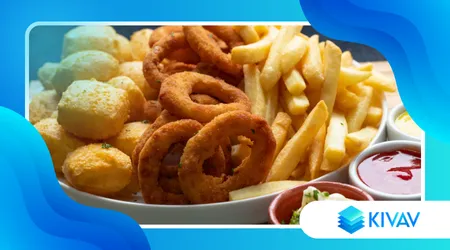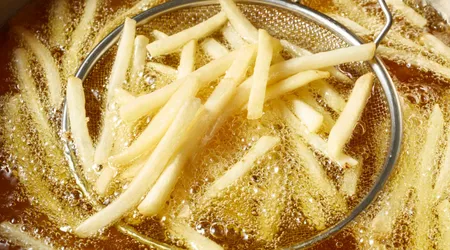Techniques for Perfect Frying

There perfect frying It's a culinary art that combines technique, patience, and creativity. In Italy, where cuisine is synonymous with tradition and innovation, frying well is almost a ritual.
Announcements
Whether it's golden supplì, potato croquettes, or crispy calamari, the result must be light, dry, and irresistible.
But how do you get one? perfect frying?
This article explores up-to-date techniques, practical tricks, and essential tips to take your frying to the next level.
Get ready to discover the secrets of impeccable crispiness, with an eye on health and sustainability, to satisfy even the most demanding palates in 2025.
Announcements
Frying isn't just about immersing food in hot oil: it's a process that requires precision and knowledge. Every detail, from the choice of oil to the temperature, affects the result.
On this culinary journey, we'll guide you step by step, with practical examples and advice based on authoritative sources.
According to a 2023 study by the National Research Council (CNR), properly frying can reduce oil absorption by up to 30%, improving taste and lightness.
Ready to turn your fried foods into masterpieces? Find out how!
Choosing the Right Oil: The Heart of Perfect Frying
Oil is the undisputed protagonist of the perfect fryingNot all oils are created equal: the smoke point, or the temperature above which the oil burns, is crucial.
Extra virgin olive oil, with a smoke point of around 190-210°C, is ideal for savory fried foods like meatballs. However, for higher-temperature fried foods, such as calamari, peanut oil (smoke point 230°C) is an excellent choice.
++ How to Knead Homemade Pasta
Don't underestimate quality: refined or low-purity oils can alter the flavor. A tip? Mix sunflower seed oil with a tablespoon of extra virgin olive oil for the perfect balance.
In 2025, the trend is towards sustainable oils, such as certified organic ones.
Finally, consider the quantity: the oil needs to be generous to avoid temperature fluctuations. A deep pan with 2 liters of oil is perfect for even frying.

Temperature: The Secret to Impeccable Crispness
Controlling the temperature is essential for a perfect fryingToo low, and the food absorbs oil and becomes mushy; too high, and it burns on the outside but remains raw on the inside.
The ideal temperature varies: 160-170°C for vegetables, 180-190°C for fish. Use a cooking thermometer for accuracy.
A practical example: for French fries, pre-cook them at 160°C, then heat them to 190°C for the final browning. This double step ensures crispiness.
Don't have a thermometer? Try the wooden spoon trick: if bubbles form when you dip it in, the oil is ready.
Thermal stability is equally important. Don't overcrowd the pan: frying a few portions at a time keeps the oil hot and even.
Batter and Breading: Textures that Conquer
A perfect frying It's not just a matter of oil, but also of coating. The light and airy batter is ideal for vegetables and shrimp.
Use 00 flour, cold sparkling water, and a pinch of baking soda for crispy bubbles. For example, an Italian-style tempura with zucchini calls for a batter chilled to 5°C.
Breading, on the other hand, is perfect for cutlets or croquettes. Alternate flour, egg, and breadcrumbs, pressing lightly to ensure they stick.
Try panko breadcrumbs for an extra-crunchy finish. Tip? Let the breadcrumbs rest in the refrigerator for 15 minutes before frying.
Avoid overly thick batters: they absorb more oil. Experiment with rice flour for surprising lightness, a 2025 trend.
The Importance of Raw Materials and Preparation
The quality of the ingredients is the foundation of a perfect fryingChoose fresh produce: freshly caught calamari or seasonal vegetables make all the difference.
For example, for fried artichokes, use tender hearts and slice them thinly for even cooking.
Dry ingredients thoroughly before frying: moisture is the enemy of crispiness. Use paper towels for fish or vegetables.
Also, add salt only after frying: salt attracts moisture, ruining the texture.
An analogy? Frying is like painting: a quality canvas (fresh ingredients) and precise brushstrokes (preparation) create a masterpiece.
Cooking Techniques: Details That Make the Difference
Each food requires a specific technique for a perfect fryingFor fish, dip slowly to prevent sticking.
Meatballs require gradual cooking at 170°C for a tender center. Don't turn the food too early: allow the crust to form.
An original example: for potato croquettes, fry them at 175°C for 3 minutes, then drain and let them rest for 1 minute before a final quick fry. This "rest" seals in the flavors.
Use a slotted spoon to drain the food, avoiding piercing it. Small steps, big results.
After Frying: How to Maintain Crispyness
The work doesn't end when the food leaves the oil. For a perfect fryingDrain on paper towels, but don't overlap the pieces: the steam will soften the crust. Serve immediately to enjoy the crispiness.
A tip? Place fried foods on a raised rack to allow air to circulate. Avoid covering them: trapped heat creates condensation. In 2025, food bloggers recommend bamboo trays for optimal drainage.
If you need to store them, use a 100°C oven to keep them warm without compromising the texture.
Health and Sustainability: Frying with Consciousness
Healthy frying is possible. Use fresh oils: reused oil produces harmful compounds. Filter the oil after each use to remove residue. perfect frying It is not only good, but also responsible.
Choose sustainable oils and dispose of them correctly at collection centers.
In 2025, environmental awareness is high: Italian restaurants are adopting organic oils. Furthermore, frying small portions reduces waste.
Eating fried foods in moderation is key. Serve with raw vegetables for a balanced meal.
Mistakes to Avoid for Perfect Frying
Mistakes are everywhere. Using old oil compromises flavor and health. Frying at the wrong temperatures ruins the texture. Not checking the temperature is a common mistake.
Don't crowd the pan: the food will stick and the oil will cool. Avoid adding salt first: it ruins the crispiness. An example? Frying moist zucchini will result in a mushy result.
Learn from your mistakes. With practice and focus, every fried dish will be a success.
Table: Parameters for Perfect Frying
| Food | Temperature (°C) | Time (minutes) | Recommended oil |
|---|---|---|---|
| French fries | 160-190 | 5-7 | Peanut |
| Squid | 180-190 | 2-3 | Sunflower seeds |
| Vegetables in batter | 160-170 | 3-5 | Extra virgin olive oil |
| Meatballs | 170 | 4-6 | Mixed (olive + seeds) |
Conclusion: Perfect Frying Is Within Your Reach
Reach a perfect frying It's a journey that combines technique, passion, and care. From choosing the oil to managing the temperature, every step counts.
With the right tricks, you can transform simple ingredients into memorable dishes. It's more than just cooking; it's an experience that speaks of tradition and innovation.
What's your next fried dish to try? Experiment, learn, and surprise your palate. In 2025, Italian cuisine continues to teach us that the details make the difference. Enjoy your fried food!
Frequently Asked Questions
Which oil is best for frying?
Peanut oil is versatile for high temperatures, but extra virgin olive oil adds flavor. Choose fresh, organic oils.
Can I reuse the oil?
Yes, but filter it after each use and don't fry it more than 2-3 times. Dispose of it at recycling centers.
How to prevent fried food from absorbing too much oil?
Use the right temperatures, dry the ingredients, and don't crowd the pan. A light batter helps.
Why isn't my fried food crispy?
It could be the humidity of the ingredients, a temperature that is too low, or a poorly adhered breading.
